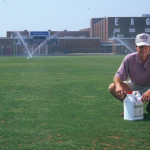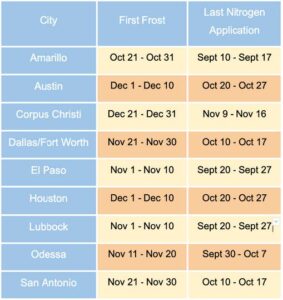 For many Texans, September typically means cooler temperatures, rain showers, and the end of the long hot summer. This change of seasons has an effect on the growth of warm-season grasses like St. Augustinegrass, zoysiagrass, and bermudagrass. Three management practices to focus on this fall and winter are watering, mowing, and fertilizing. Adjusting these to match the seasonal change can create a strong healthy lawn throughout the fall and into winter dormancy.
For many Texans, September typically means cooler temperatures, rain showers, and the end of the long hot summer. This change of seasons has an effect on the growth of warm-season grasses like St. Augustinegrass, zoysiagrass, and bermudagrass. Three management practices to focus on this fall and winter are watering, mowing, and fertilizing. Adjusting these to match the seasonal change can create a strong healthy lawn throughout the fall and into winter dormancy.
Watering
As the days get shorter and temperatures become cooler, the growth rate of grass slows down, therefore less water is necessary to maintain plant health. This drop in water need can be ½ or ¾ of what is required in summer. Overwatering during this time of year can have a devastating effect on turfgrass. Common warm-season turfgrass diseases are large patch (caused by Rhizoctonia solani) and take-all root rot (caused by Gaeumannomyces graminis). Both are fungal diseases brought on by cool, moist conditions. When temperatures drop below 70°F, automatic irrigation should be stopped and done only as necessary under dry weather conditions. Follow local watering recommendations to prevent overwatering. Websites like Water My Yard, Texas ET Network; and Water Is Awesome provide weekly watering advice based on local weather information so you know whether to water or not. Some of these services are app-based as well. Check for availability in your local area.

Mowing
The slowdown in turfgrass growth naturally comes with a slowdown in mowing frequency. However, the mowing done during this period can have an impact on the turfgrass leading up to winter dormancy. Consider raising the mower height a bit, but don’t exceed the recommended height of cut for your turfgrass. Raising the cut height will encourage deeper root growth below ground, aiding in overwintering. The taller grass also shades to soil, helping with moisture retention and preventing the germination of winter weeds. Finally, a sharp cut is best for your lawn any time of year, so take advantage of the season and sharpen your mower blades.
Fertilizing

Fall lawn fertilization can be tricky due to the varied weather we see in Texas. It is highly recommended that a soil test be done in late summer or early fall to confirm the existing nutrient status before adding fertilizer. Low plant nitrogen levels can have adverse effects on turfgrass emergence from winter dormancy. However, applying additional nitrogen when current levels are elevated can result in increased disease pressure (especially in St. Augustinegrass and zoysiagrass), winter weed growth, and potential localized water pollution. Our recommendation is to apply your final nitrogen fertilization no later than 6 weeks prior to the historical first frost date for your region. If a soil test is not possible, simple observations of the growth of your lawn in the weeks prior to the recommended fertilizer application date can be used as an indicator. If growth levels are still high, additional nitrogen may not be needed at all.
Summary
Remember, observing your local weather conditions and adjusting the lawn care management practices above to match can provide a beautiful lawn that’s ready for a nice winter rest without all the guesswork. For additional information on turfgrass care and maintenance visit https://aggieturf.tamu.edu or contact your County Extension Agent for local advice.
Check out the fact sheet you can print and share. Water, fall 2023
Written By: Dean Minchillo: Extension Program Specialist – Urban Water; Texas A&M AgriLife Extension Service, Dallas, TX

 .
.